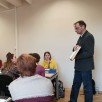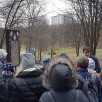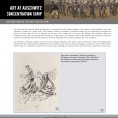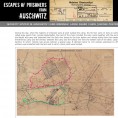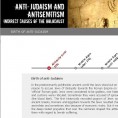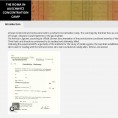Volunteers of the Memorial honoured with the awards “If Not for Those Ten... ”
Seminar in collaboration with the academic centre for oral history in Voronezh
International Summer Academy 2019 in English and German - Call for Participants
Educational challenges in authentic memorial sites
E-learning
A visit to the authentic Memorial Site is a unique educational experience. However, people who do not have the ability to visit the former concentration camp of Auschwitz now have the opportunity to become acquainted with its history through education conducted via the Internet. Whereas for those who have already visited the place, remote access to educational materials will help in deepening the knowledge gained during the visit. E-learning can also be used as an aid in preparing visitors to the Memorial Site.
Auschwitz – concentration and extermination camp
Authors: Dr Jacek Lachendro, Dr Piotr Setkiewicz
Preparing for a visit to the Memorial Site. This is a compendium of knowledge about the history of the Nazi German concentration and extermination camp of Auschwitz. It includes a historical introduction, excerpts of accounts by former prisoners, photographs and archival documents, maps, examples of camp art, as well as teaching exercises. Lessons are addressed to secondary school pupils, students and adults. The lesson can also be used as a preparation for a visit to the Auschwitz Memorial Site.
Art at Auschwitz
Author: Agnieszka Sieradzka
'Art at Auschwitz concentration camp' – is a new online lesson prepared by the International Center for Education about Auschwitz and the Holocaust. It is dedicated to a unique document which shows the reality of functioning of the German Nazi concentration and extermination camp Auschwitz as well as the fate if its victims – works of art made by the prisoners. The author of the lesson is Agnieszka Sieradzka, an art historian who works at the Collections of the Memorial.
Auschwitz Museum in the first years of its operation
Author: Dr Jacek Lachendro
The lesson tells the story of the period 1945-1955, from the first works on establishing the Museum, through the beginning of organising the visits at the Museum which had 100 thousand visitors in 1946 before the official opening, creation of the first exhibition, Stalinist period when Museum was used for propaganda till 1955 when the authorities gave up imbuing its content with extreme political messages, and former prisoners of Auschwitz again could be a major inspiration for its shape’
Christian Clergy and Religious Life at Auschwitz
Author: Teresa Wontor-Cichy
The lesson presents profiles of priests and clerics, nuns, and clergy of other Christian churches incarcerated by the Germans in Auschwitz. It also describes stories of later Saints and Blesseds, among others St Maximilian Kolbe and St Teresa Benedicta of the Cross (Edith Stein). It also shows various aspects of religious life in the camp, led by the prisoners, risking their lives.
Deportations of Hungarian Jews to Auschwitz
Author: Dr Piotr Setkiewicz
The main topic is the extermination of the Hungarian Jews to Auschwitz, but the lesson also describes the history of the Jewish community in this country before the Second World War and during the period before the deportations. The lesson is available in two language versions - Polish and English. It is based on an extensive historical lecture to which fragments of former prisoners’ testimonies, multimedia, photographs, archival documents and maps are added.
Escapes from KL Auschwitz
Author: Dr Jacek Lachendro
It describes among others, the geographical location of the Auschwitz camp, its security system, alarm system, repressions faced by captured escapees, the collective revolts and finally tells the stories of 25 selected escapes.
Evacuation and liberation of KL Auschwitz
Author: Dr. Jacek Lachendro
GO TO THE LESSON
The lesson consists of a dozen parts concerning among others the initial stage of liquidation of the camp in late 1944, final days of the camp, liberation and medical assistance provided to liberated prisoners. Historical description is enriched with archive photographs, documents, excerpts of accounts by former prisoners and fragments of films, e.g. Liberation Chronicle or a unique video showing an evacuation transport of prisoners from Auschwitz passing through the station in Kolin on January 24, 1945.
Extermination of Jews at KL Auschwitz
Author: Dr. Piotr Setkiewicz
"At the beginning it describes the history of Jewish prisoners that Germans brought to Auschwitz before the beginning of mass extermination in gas chambers. The lesson then analyses the chronology of events in spring 1942 when Auschwitz was turned into a center of extermination of Jews in gas chambers, it describes the situation of of Jewish prisoners, history of the Jewish resistance as well as a unique story of a family camp for Jews deported from Theresienstadt ghetto as well as transit camps created in Birkenau. The last chapter tells about evacuation and liberation of KL Auschwitz.
It's available in English, French, German, Polish and Spanish.
Fate of Soviet prisoners in Auschwitz
Author: Jacek Lachendro
GO TO THE LESSON
Altogether 11,964 prisoners of war were registered in the German Nazi concentration and extermination Auschwitz camp, and there was moreover an estimate of 3,000 soldiers of the Red Army who were brought to the camp and killed without being entered into the registers. Thus, altogether, around 15,000 of captive Red Army soldiers were sent to the camp. Accounting for the few hundred who were removed from the camp and the several dozen who escaped, the estimated number of Soviet prisoners of war who died or were killed in Auschwitz exceeded 14,000.
First deportations of Poles to Auschwitz
Author: Irena Strzelecka
The lesson tells the story of the first weeks of the newly created Nazi German Auschwitz camp and its first prisoners - Poles deported from the Cracow district in the General Government: from prisons in Tarnów (June 14, 1940.), Nowy Wiśnicz (June 20 1940) and Montelupich in Cracow (July 18, 1940.), and a group of 271 prisoners brought to Auschwitz in June and early July 1940, from the transit camp in Sosnowiec in the Katowice region.
From the uprising Warsaw to Auschwitz
Author: Helena Kubica.
Deportees sent to Auschwitz after the outbreak of an armed Uprising in Warsaw constitute the topic of the lesson. In August and September 1944, nearly 13 thousand arrested citizens of Warsaw, men, women and children, were deported to KL Auschwitz through transit camp in Pruszków. They were imprisoned in Auschwitz II-Birkenau. Transports which arrived in Auschwitz on August 12 and 13 were the most numerous, with the total number of nearly 6 thousand people (including ca. 4 thousand women and 2 thousand men, with over 1 thousand children and teenagers of both sexes among them).
Holocaust–the destruction of European Jews — course
Preparation to the visit at the Auschwitz Memorial for youth over 13 years old
Authors: Adam Musiał and Monika Witalis-Malinowska
The first part of the lesson presents basic information about the Nazi ideology - how the Nazi party came to power in Germany, how it reduced democracy and liquidated political opponents, and how the antisemitic policy escalated. The second part describes the concepts of "protective detention" in the German Third Reich, the establishment of the first concentration camps, the reasons for establishing Auschwitz as a concentration camp for Polish political prisoners, as well as the reality of life of prisoners. The last part is dedicated to the extermination of Jews both in occupied Europe and in the Auschwitz camp. A separate chapter tells about the extermination of Roma and Sinti.
The lesson is also available in Dutch.
Preparation for a visit to the Auschwitz Memorial
Author: Mirosław Obstarczyk
"Auschwitz - Memorial Site" is an online, whose main task is to prepare for a visit to the former German Nazi concentration and extermination camp. The author of the lesson is Miroslaw Obstarczyk, an employee of the Museum and long-standing educator-guide, who often works with young people visiting the Memorial Site. Besides historical texts, the lesson contains many pictures, maps, interactive diagrams, accounts and documents. All this in order for the user to receive a very clearly outlined historical context, which the plot is the story of Auschwitz.
DUTCH language version
Resistance Movement in KL Auschwitz
Author: Dr. Adam Cyra
Organised clandestine activity took place at Auschwitz from the very beginning of its operation. Initially it was conducted by Polish political prisoners. Only when people deported from other European countries occupied by the Third Reich began to be imprisoned in the camp in mid-1941, and when it became a place of mass murder of Jews in the spring of 1942, did the inmate resistance movement also encompass inmates of other nationalities
Roma in Auschwitz
Author: Teresa Wontor-Cichy
The main topic of the lesson is the history of deportations and the subsequent extermination of Roma and Sinti in the Auschwitz camp. The lesson describes inter alia how they were considered enemies of the Third Reich. At first, they were transported to the area of General Government, and subsequently to the Kulmhof extermination camp, where they were murdered in gas chambers.

